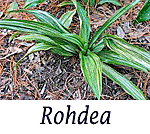|
  This hosta is the focus of some differing opinions. Two forms of
it were found in
Japan and they were given different names as if
they were naturally occurring forms of a single species. Here is
a brief summary of the debate (as I understand it anyway). This hosta is the focus of some differing opinions. Two forms of
it were found in
Japan and they were given different names as if
they were naturally occurring forms of a single species. Here is
a brief summary of the debate (as I understand it anyway).
One
of these hostas was known as H.  rohdeifolia rohdeifolia.
In the book
The Genus Hosta by
W.
George Schmid (1991), it was determined that this plant did not come
from the wild but, rather, came from cultivation. Therefore, it
was "downgraded" to cultivar status and is to be known as H.
rohdeifolia 'Rohdeifolia'. It is not a species.
However, in the
The Hosta Handbook (2000),
Mark Zilis feels that it is actually the true species,
Hosta rohdeifolia. rohdeifolia rohdeifolia.
In the book
The Genus Hosta by
W.
George Schmid (1991), it was determined that this plant did not come
from the wild but, rather, came from cultivation. Therefore, it
was "downgraded" to cultivar status and is to be known as H.
rohdeifolia 'Rohdeifolia'. It is not a species.
However, in the
The Hosta Handbook (2000),
Mark Zilis feels that it is actually the true species,
Hosta rohdeifolia.
 The other plant was named H. rohdeifolia viridis
and was known in
Japan as the "green-leaved hosta with leaves
like Rohdea". Schmid says that this is the true species,
H. rohdeifolia. The other plant was named H. rohdeifolia viridis
and was known in
Japan as the "green-leaved hosta with leaves
like Rohdea". Schmid says that this is the true species,
H. rohdeifolia.
Either way, we are talking about a medium size hosta (14 to 16
inches high by 12 to 16 inches wide) with a generally erect
form. 'Rohdeifolia' has dark green foliage with a thin, white
marginal variegation. The leaves are slightly convolute, oblong-lanceolate
in shape. Its pale purple, funnel-shape flowers with light
yellow anthers bloom in August.
 "Fukurin
Omoto Gibōshi, the "(white) margined hosta with leaves like
Rohdea," looks like H. sieboldii but is much larger
in all respects....A hosta called H. rhodeifolia 'Albo-marginata'
is cultivated in the United States; it is not this hosta but
H. 'Fortunei Gloriosa'. This is a Japanese cultivar
selection of minor importance which has not seen horticultural
use in Western gardens." "Fukurin
Omoto Gibōshi, the "(white) margined hosta with leaves like
Rohdea," looks like H. sieboldii but is much larger
in all respects....A hosta called H. rhodeifolia 'Albo-marginata'
is cultivated in the United States; it is not this hosta but
H. 'Fortunei Gloriosa'. This is a Japanese cultivar
selection of minor importance which has not seen horticultural
use in Western gardens."
Mikiko Lockwood in an article on The Hosta Library titled,
A Little About Japanese Hosta Terms defines the term fukurin as margined or edged. |



